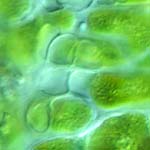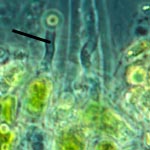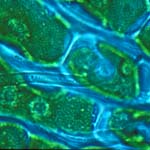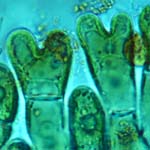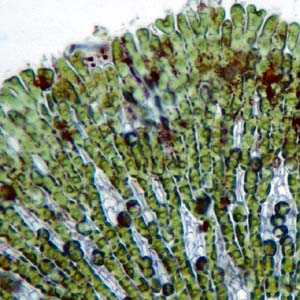Classification: Eukarya, Charophyta, Coleochaetophyceae, Coleochaetales, Coleochaetaceae
Synonomy: C. scutata var. soluta Bréb., C. soluta var brevicellularis Schmidle.
Description: Thalli up to 1 mm in diameter,
First present overall appearance and size, including ranges if known; description of vegetative thallus. Cell sizes and other quantitative descriptions of form should be provided whenever possible. This should be followed by cellular detail in a consistent order. Following the description of the vegetative thallus, describe reproductive features, presenting them in the order in which they appear in the life cycle, typically oogonia, antheridia, zygotes. Finally describe the germination of the zygote and early stages of development. Italicize key terms; these will eventually be linked to a glossary. The text shouldbe as clear as possible, and should strive for consistency with other entries.
Follow the description with a brief set of hints for how to recognize it; in particular, indicate how the organism can be distinguished from superficially similar species.
Habit shot (300x300 pixels) should show the overall form of the organism. Ideally it would show both vegetative and reproductive characters, but the most important thing is that it be recognizable as the species indicated.
The caption for the habit shot should identify the organism, the location and date of collection, provide an indication of size. Audit information should be provided so that the image can be tracked to field and lab records.
Note: Coleochaete soluta is often confused with C. circularis and related species. It is, however, quite distinctive to the practiced eye, and can be recognized by the presence of corticated zygotes.
Coleochaete soluta from LOCATION
SCALE. [SOURCE, DATE, ETC]
The chloroplasts of many species of Coleochaete rotate around the base of the hair. Click here for a quicktime movie showing plastid movement in C. soluta.
Additional Information
This section should provide general biological information, not necessarily directly relevant to its identification. Brief explanations of the detail images (at right) can also be put here, but if lengthy explanation is required, a special page specific to that character should be created.
How to find it: Information on where the organism can be found in nature. If it is available from suppliers, indicate that here.
How to grow it: Information on how to culture the organism. If the life cycle can be controlled, provide a brief description and citations.
Key Literature: This should include the original citation, major revisions and monographs, and other key sources. This should include more than just pure taxonomic information, but should be kept to 3-5 key citations.
This entire page should be designed to print on a standard sheet of letter paper. When any of the sections requires additional space, put a brief abstract on the appropriate section on this page, then prepare a second HTML page with full detail and put a link like this: [MORE] at the end of the appropriate section.
All figures should provide a clear indication of scale, and typically will be linked to a larger version of the same image.
Zygote cortication in C. soluta
Detail images are 150x150 pixels, and should be linked to a high-resolution image.
The scale should be indicated for each image.
In some cases a drawing or figure will be more informative than a photo or micrograph.
